| Listing 1 - 10 of 10 |
Sort by
|
Book
ISBN: 1949163008 9781949163001 Year: 2018 Publisher: New York: American Institute of Buddhist Studies,
Abstract | Keywords | Export | Availability | Bookmark
 Loading...
Loading...Choose an application
- Reference Manager
- EndNote
- RefWorks (Direct export to RefWorks)
The Vaidalyaprakarana provides a rare glimpse of the sophisticated philosophical exchange between Buddhist and non-Buddhist schools at an early stage and will be of interest to scholars of Buddhist thought, classical Indian Philosophy, and the history of Asian thought.Belonging to a set of Nagarjuna’s philosophical works known as the yukti-corpus, the Vaidalyaprakarana is noteworthy for its close engagement with the Hindu philosophers. It refutes the sixteen categories of the Nyaya school, which formed the logical and epistemological framework for many of the debates between Buddhist and Hindu philosophers.The Sanskrit original of the Vaidalyaprakarana long lost, the author translates the text from Tibetan, giving it an extensive analytical commentary. The aim is twofold: to investigate the interaction of the founder of the Madhyamika school with this influential school of Hindu thought; and to make sense of how Nagarjuna’s arguments that refute the Naiyayika categories are essential to the Madhyamika path in general.
Book
ISBN: 7802537878 9783700177647 9787802537873 7802537878 370017764X 9787802537873 Year: 2014 Publisher: Vienne: Austrian academy of sciences press,
Abstract | Keywords | Export | Availability | Bookmark
 Loading...
Loading...Choose an application
- Reference Manager
- EndNote
- RefWorks (Direct export to RefWorks)
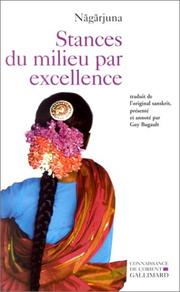
ISBN: 2070767302 9782070767304 Year: 2002 Volume: 107 Publisher: Paris : Gallimard,
Abstract | Keywords | Export | Availability | Bookmark
 Loading...
Loading...Choose an application
- Reference Manager
- EndNote
- RefWorks (Direct export to RefWorks)
Qui désire comprendre la source indienne de l'Ecole chinoise du Dhyana (Ch'an), du Zen japonais ou de la dialectique du bouddhisme tibétain doit remonter au texte fondateur : l'original sanskrit des Stances du milieu par excellence, du moine indien Nagarjuna (IIe-IIIe siècle de notre ère), dont l'influence fut immense en Asie. Ce texte fondamental est un dialogue critique avec les tenants de la scolastique du bouddhisme ancien qui avaient tendance à " prendre des mots pour des choses ", alors que l'enseignement du Bouddha était avant tout pratique et thérapeutique. Nagarjuna passe en revue des topiques familiers à la communauté bouddhique, mais aussi d'autres qui relèvent du sens commun, et les soumet à un examen critique implacable. Il nous invite ainsi à une remise en question, paradoxale et purgative, de certains de nos schèmes mentaux et vitaux tels que cause-effet, commencement-fin, identité-altérité, apparitiondisparition, mais aussi le mouvement, les choses, les êtres et leur (im) permanence, les passions, le moi, la souffrance, l'acte et ses fruits, les méprises, les nobles vérités, ce qu'il peut y avoir derrière des mots comme vacuité, nirvana, etc. La dialectique évacuatrice de Nagarjuna - qui a pour ressort une logique originale avec trois opérateurs (formels ou sémantiques) et un mode de raisonnement typiquement bouddhique (le tétralemme) - s'abolit dans sa phase ultime et ouvre la voie à une méditation sans intention ni parole.
Central philosophy (Buddhism) --- Chugan shiso --- Madhyamika (Boeddhisme) --- Madhyamika (Bouddhisme) --- Madhyamika (Buddhism) --- Madhyamikasastra --- Middle doctrine school(Mahayana Buddhism) --- Middle school (Mahayana Buddhism) --- Sunyavada (Buddhism) --- Mādhyamika (Buddhism) --- Nágárjuna --- Mādhyamika (Buddhism) - Early works to 1800 --- Mādhyamika (Buddhism). --- Nāgārjuna,
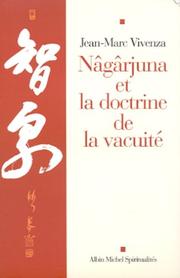
ISSN: 0755172X ISBN: 2226122273 9782226122278 Year: 2001 Publisher: Paris: Albin Michel,
Abstract | Keywords | Export | Availability | Bookmark
 Loading...
Loading...Choose an application
- Reference Manager
- EndNote
- RefWorks (Direct export to RefWorks)
Sunyata. --- Madhyamika (Buddhism) --- 'Sunyata --- Madhyamika (Bouddhisme) --- Nagarjuna, --- Madhyamika (Bouddhisme). --- Mādhyamika (Buddhism) --- ʹSūnyatā --- Mādhyamika (Bouddhisme) --- Nāgārjuna,
Book
ISSN: 15709434 ISBN: 9789004186538 9004186530 9004193790 1283856352 9789004193796 Year: 2010 Volume: 129 Publisher: Leiden ; Boston : Brill,
Abstract | Keywords | Export | Availability | Bookmark
 Loading...
Loading...Choose an application
- Reference Manager
- EndNote
- RefWorks (Direct export to RefWorks)
Shin Buddhism (Jōdo Shinshū), although weakened in many ways by secularization, continues to be a stable presence in Japanese society, as is emblematically shown by the very symmetrical position of the Nishi (Honganji-ha) and the Higashi Honganji (Ōtani-ha) head temples in the center of Kyōto, and by the recent projects for their renovation. This book addresses the need for more academic research on Shin Buddhism, and is specifically directed at describing and analyzing distinctive social aspects of this religious tradition in historical and contemporary perspective. The contributions collected here cover a wide range of issues, including the intersection between Shin Buddhism and fields as diverse as politics, education, social movements, economy, culture and the media, social ethics, gender, and globalization.
Shin (Sect) --- Religion and sociology --- Shin (Secte) --- Sociologie religieuse --- Social aspects --- Aspect social --- 294.3*922.2 --- Leer van het Mahayanaboeddhisme: Madhyamika (Nagarjuna; Sanron); Yogacara (Vasubandu; Hosso); Avatamsaka (Kegon); Saddharmapundarika (Tendai); Zuivere Land (Jodo; Shin; Ji); Nichiren --- 294.3*922.2 Leer van het Mahayanaboeddhisme: Madhyamika (Nagarjuna; Sanron); Yogacara (Vasubandu; Hosso); Avatamsaka (Kegon); Saddharmapundarika (Tendai); Zuivere Land (Jodo; Shin; Ji); Nichiren --- Social aspects. --- Jodo-shin-shu --- Buddhist sects --- Pure Land Buddhism --- Shin (Sect) - Social aspects --- Religion and sociology - Japan --- Shin Buddhism --- Japanese society --- Honen's Pure Land doctrines --- Burakumin --- the Edo period --- Shinsu studies --- liberal thought in Japan --- gender --- media --- Shin Buddhism and globalization --- Japan --- japanese religions --- Buddhism
Book
ISBN: 9781935413165 9781935413172 9781935413189 1935413163 193541318X 1935413171 Year: 2019 Volume: 13a, 13b Publisher: Seattle: Kalavinka press,
Abstract | Keywords | Export | Availability | Bookmark
 Loading...
Loading...Choose an application
- Reference Manager
- EndNote
- RefWorks (Direct export to RefWorks)
""Nāgārjuna's Treatise on the Ten Bodhisattva Grounds" is Bhikshu Dharmamitra's extensively annotated original translation of Ārya Nāgārjuna's "Daśabhūmika Vibhasa" rendered from Tripiṭaka Master Kumārajīva's circa 410 ce Sanskrit-to-Chinese translation. It consists of 35 chapters that explain in great detail the cultivation of the ten highest levels of bodhisattva practice leading to buddhahood, focusing almost exclusively on the first two of the ten bodhisattva grounds. This is a work which has never been translated into English before"--
Bodhisattva stages (Mahayana Buddhism) --- Nāgārjuna, --- Tripiṭaka. --- Criticism, interpretation, etc. --- Bodhisattva bhūmis --- Fifty-two stages (Mahayana Buddhism) --- Ten stages (Mahayana Buddhism) --- Religious life --- Mahayana Buddhism --- Daśabhūmīśvara --- Daśabhūmikasūtra --- Daśabhūmika-sūtra --- 294.3*922.2 --- 294.3*922.2 Leer van het Mahayanaboeddhisme: Madhyamika (Nagarjuna; Sanron); Yogacara (Vasubandu; Hosso); Avatamsaka (Kegon); Saddharmapundarika (Tendai); Zuivere Land (Jodo; Shin; Ji); Nichiren --- Leer van het Mahayanaboeddhisme: Madhyamika (Nagarjuna; Sanron); Yogacara (Vasubandu; Hosso); Avatamsaka (Kegon); Saddharmapundarika (Tendai); Zuivere Land (Jodo; Shin; Ji); Nichiren --- Nāgārjuna, - active 2nd century. - Daśabhūmivibhāṣāśāstra
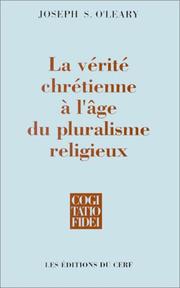
ISBN: 220404900X 9782204049009 Year: 1994 Volume: 181 Publisher: Paris: Cerf,
Abstract | Keywords | Export | Availability | Bookmark
 Loading...
Loading...Choose an application
- Reference Manager
- EndNote
- RefWorks (Direct export to RefWorks)
Religious pluralism --- Christianity and other religions. --- Pluralisme religieux --- Christianisme --- Christianity. --- Relations --- Nagarjuna, --- 261 --- Christianity and other religions --- -#gsdb3 --- Pluralism (Religion) --- Pluralism --- Religion --- Religions --- Christianity --- Syncretism (Christianity) --- Verschillende betrekkingen van de Kerk; de Kerk in een pluralistische maatschappij --- History --- Nagarjuna --- Nāgārjuna, --- #gsdb3 --- Luzhu, Bangongpaba, --- Lu-chu, Pan-kung-pʻa-pa, --- 魯珠, 班贡帕巴, --- Longmeng, --- Lung-meng, --- 龙猛, --- Longshu, --- Lung-shu, --- Ryūju, --- 龙树, --- 龍樹, --- Longsheng, --- Lung-sheng, --- 龙胜, --- Lung-hu, --- Yongsu, --- 용수, --- Ācārya Nāgārjuna, --- Ārya Nāgārjuna, --- ʼPhags-pa Klu-sgrub, --- Klu-sgrub, ʼPhags-pa, --- Slob-dpon Klu-sgrub, --- Nagardzhuna, --- Nākhānchun, --- Nākhārachun, --- Nākhānrachun, --- Long Thọ Đại Sĩ, --- Bồ Tát Long Thọ, --- Nagarzhuna, --- Lu-Trub, --- Religious pluralism - Christianity. --- Fransen (don)
Book
ISBN: 083480106X 0834801051 9780834801066 Year: 1975 Publisher: New York: Weatherhill,
Abstract | Keywords | Export | Availability | Bookmark
 Loading...
Loading...Choose an application
- Reference Manager
- EndNote
- RefWorks (Direct export to RefWorks)
In this book three scriptures are presented together for the first time in English: the Lotus Sutra, innumerable meanings, meditation on the Bodhisattva Universal Virtue (Buddhism, religion, world, life style).
845 Religie --- 846 Identiteit --- 880 Regios en landen --- S37/0780 --- Buddhism outside China, Tibet, Mongolia and Japan--Buddhist texts and commentaries: others --- 294.3*922.2 --- J1821.20 --- S37/0770 --- Leer van het Mahayanaboeddhisme: Madhyamika (Nagarjuna; Sanron); Yogacara (Vasubandu; Hosso); Avatamsaka (Kegon); Saddharmapundarika (Tendai); Zuivere Land (Jodo; Shin; Ji); Nichiren --- Japan: Religion -- Buddhism -- scriptures -- sutra -- Lotus sutra (Hokekyō) --- Buddhism outside China, Tibet, Mongolia and Japan--Buddhist texts and commentaries: Mahayana Sutra --- 294.3*922.2 Leer van het Mahayanaboeddhisme: Madhyamika (Nagarjuna; Sanron); Yogacara (Vasubandu; Hosso); Avatamsaka (Kegon); Saddharmapundarika (Tendai); Zuivere Land (Jodo; Shin; Ji); Nichiren --- Mahayana Buddhism --- #SML: Joseph Spae --- Sacred books --- Tripiṭaka. --- Bonbun hokekyō --- Cheng fa hua ching --- Chʻŏm myopŏp yŏnhwagyŏng --- Chʻŏmpʻum myopŏp yŏnhwagyŏng --- Chŏng pŏphwagyŏng --- Dam paʼi chos padma dkar po las mos paʼi leʼu --- Fa hua ching --- Lotus de la bonne loi --- Lotus Sutra --- Miao fa lian hua jing --- Miao fa lien hua ching --- Myobŏp yŏnhwagyŏng --- Pophwagyŏng --- Saddharma-pundarîka --- Saddharmapuṇḍarīka --- Saddharmapuṇdarīka-sūtram --- Sūtra del Loto --- Tʻien pʻin miao fa lien hua ching --- Sūtra du Lotus
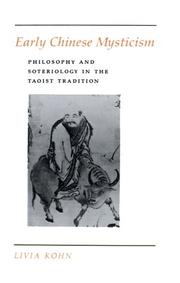
ISBN: 0691073813 0691020655 9780691020655 1400844460 Year: 1992 Publisher: Princeton (N.J.) : Princeton university press,
Abstract | Keywords | Export | Availability | Bookmark
 Loading...
Loading...Choose an application
- Reference Manager
- EndNote
- RefWorks (Direct export to RefWorks)
"Did Chinese mysticism vanish after its first appearance in ancient Taoist philosophy, to surface only after a thousand years had passed, when the Chinese had adapted Buddhism to their own culture? This first integrated survey of the mystical dimension of Taoism disputes the commonly accepted idea of such a hiatus. Covering the period from the Daode jing to the end of the Tang, Livia Kohn reveals an often misunderstood Chinese mystical tradition that continued through the ages. Influenced by but ultimately independent of Buddhism, it took forms more various than the quietistic withdrawal of Laozi or the sudden enlightenment of the Chan Buddhists." "On the basis of a new theoretical evaluation of mysticism, this study analyzes the relationship between philosophical and religious Taoism and between Buddhism and the native Chinese tradition. Kohn shows how the quietistic and socially oriented Daode jing was combined with the ecstatic and individualistic mysticism of the Zhuangzi, with immortality beliefs and practices, and with Buddhist insight meditation, mind analysis, and doctrines of karma and retribution. She goes on to demonstrate that Chinese mysticism, a complex synthesis by the late Six Dynasties, reached its zenith in the Tang, laying the foundations for later developments in the Song traditions of Inner Alchemy, Chan Buddhism, and Neo-Confucianism. Book jacket."--Jacket.
Mysticism --- Taoism --- Taoist philosophy --- Mysticisme --- Taoïsme --- Philosophie taoïste --- China --- Chine --- Religion. --- Religion --- Philosophy, Taoist. --- Taoism. --- S12/0500 --- S13A/0401 --- S13A/0200 --- S12/0210 --- China: Philosophy and Classics--Laozi and Taoism (incl. Daodejing) --- China: Religion--Popular religion: Taoism --- China: Religion--General works --- China: Philosophy and Classics--Special philosophical subjects --- Taoist philosophy. --- Taoïsme --- Philosophie taoïste --- Philosophy, Taoist --- Philosophy --- Dark night of the soul --- Mystical theology --- Theology, Mystical --- Spiritual life --- Negative theology --- Baopuzi. --- Being-cognition. --- Confucius. --- Dark Learning. --- Erjiao lun. --- Fuqi jingyi lun. --- Ge Xuan. --- Great Ultimate. --- Huangting jing. --- Jade Emperor. --- Jizang. --- Kaltenmark, Maxime. --- Lao-Zhuang tradition. --- Liezi. --- Liu Ling. --- Nāgārjuna. --- Pure Land. --- Queen Mother of the West. --- Shuijing zhu. --- Shujing. --- Sun Simiao. --- Tao Hongjing. --- Tao-nature. --- Wang Qiao. --- Xiaodao lun. --- Yang Zhu. --- Zhenzheng lun. --- absolute. --- brain hemispheres. --- chaos. --- drunkenness. --- equality of all things. --- fangshi. --- fasting. --- medicine. --- monasticism. --- ontology. --- orbs, five. --- perennial philosophy. --- rhapsody. --- scriptures. --- value judgments. --- Mysticism. --- Interfaith relations. --- Buddhism. --- Salvation --- Daoism --- Taouism --- Religions --- Tao --- Buddha and Buddhism --- Lamaism --- Ris-med (Lamaism) --- Religion, Primitive --- Atheism --- Irreligion --- Theology --- Relations --- History. --- China. --- China (Republic : 1949- ) --- Cina --- Kinë --- Cathay --- Chinese National Government --- Chung-kuo kuo min cheng fu --- Republic of China (1912-1949) --- Kuo min cheng fu (China : 1912-1949) --- Chung-hua min kuo (1912-1949) --- Kina (China) --- National Government (1912-1949) --- China (Republic : 1912-1949) --- People's Republic of China --- Chinese People's Republic --- Chung-hua jen min kung ho kuo --- Central People's Government of Communist China --- Chung yang jen min cheng fu --- Chung-hua chung yang jen min kung ho kuo --- Central Government of the People's Republic of China --- Zhonghua Renmin Gongheguo --- Zhong hua ren min gong he guo --- Kitaĭskai︠a︡ Narodnai︠a︡ Respublika --- Činská lidová republika --- RRT --- Republik Rakjat Tiongkok --- KNR --- Kytaĭsʹka Narodna Respublika --- Jumhūriyat al-Ṣīn al-Shaʻbīyah --- RRC --- Kitaĭ --- Kínai Népköztársaság --- Chūka Jinmin Kyōwakoku --- Erets Sin --- Sin --- Sāthāranarat Prachāchon Čhīn --- P.R. China --- PR China --- PRC --- P.R.C. --- Chung-kuo --- Zhongguo --- Zhonghuaminguo (1912-1949) --- Zhong guo --- République Populaire de Chine --- República Popular China --- Catay --- VR China --- VRChina --- 中國 --- 中国 --- 中华人民共和国 --- Jhongguó --- Bu̇gu̇de Nayiramdaxu Dundadu Arad Ulus --- Bu̇gu̇de Nayiramdaqu Dumdadu Arad Ulus --- Bu̇gd Naĭramdakh Dundad Ard Uls --- BNKhAU --- БНХАУ --- Khi︠a︡tad --- Kitad --- Dumdadu Ulus --- Dumdad Uls --- Думдад Улс --- Kitajska --- Mysticism - Taoism. --- Buddhism --- Prayer-books and devotions --- Tibetan --- 1949 --- -BNKhAU --- Chung-hua min kuo --- Jhonggu --- Khi͡atad --- Kin --- Kita --- Kitaĭskai͡a Narodnai͡a Respublika --- National Government --- Republic --- Republic of China --- Zhonghuaminguo
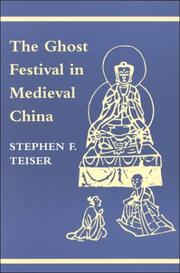
ISBN: 0691055254 0691026777 9780691055251 9780691026770 0691222177 Year: 1996 Publisher: Princeton: Princeton university press,
Abstract | Keywords | Export | Availability | Bookmark
 Loading...
Loading...Choose an application
- Reference Manager
- EndNote
- RefWorks (Direct export to RefWorks)
Largely unstudied until now, the religious festivals that attracted Chinese people from all walks of life provide the most instructive examples of the interaction between Chinese forms of social life and the Indian tradition of Buddhism. Stephen Teiser examines one of the most important of such annual celebrations. He provides a comprehensive interpretation of the festivities of the seventh lunar month, in which laypeople presented offerings to Buddhist monks to gain salvation for their ancestors. Teiser uncovers a wide range of sources, many translated or analyzed for the first time in any language, to demonstrate how the symbolism, rituals, and mythology of the ghost festival pervaded the social landscape of medieval China.
Ullambana. --- Memorial rites and ceremonies, Buddhist --- Pretas (Buddhism) --- S11/0605 --- S13A/0402 --- China: Social sciences--Folklore, festivals --- China: Religion--Mythology (incl. pantheon, ghosts, myths and legends) --- Buddhist memorial rites and ceremonies --- Moggallāna. --- Yü lan pʻen ching --- Pretas (Buddhism). --- S13A/0403 --- S13A/0400 --- China: Religion--Rites, magic, festivals --- China: Religion--Popular religion: general --- Criticism, interpretation, etc. --- Civilization, Medieval. --- Buddhist memorial rites and ceremonies. --- Moggallāna. --- Yu lan pen jing. --- Yu lan pen jing --- China. --- Abhidharmal. --- Apocrypha. --- Asvajit. --- Avici Hell. --- Black Rope Hell. --- Buddhaputra. --- Chavannes, Edouard. --- Chi-kuo ssu. --- Chih-yuan. --- Christianity. --- Class structure. --- Confucius. --- Daianji. --- Dharmagupta sect. --- Dionysus. --- Dirghdgama. --- Eighteen transformations. --- Ennin. --- Etymology. --- Examiner of Fate. --- Feast, nature of. --- Five Vehicles. --- Gernet, Jacques. --- Ghosts and ancestors. --- Gunabhadra. --- Hell of Fiery Heat. --- Hsüan-tsang. --- Impartial, King. --- Iranian religions. --- Japanese literature. --- Karma Official. --- Kolita. --- Kuan-ting ching. --- Lao-tzu. --- Lay people. --- Literacy. --- Lu-tou. --- Martial powers. --- Milky Way. --- Morality books. --- Mu-lien pien. --- Musicians. --- Mädhyamika. --- Nagarjuna. --- Nanda. --- Nirvanasūtra. --- Officer of Earth. --- Officer of Records. --- Parents. --- Prasenajit, King. --- Radha. --- Renunciation. --- Rite of passage. --- Sage. --- Sangoku denki. --- All Souls' Day (Buddhism) --- Bon Festival (Buddhist festival) --- Bon Matsuri --- Bonmatsuri --- Buddhist All Souls' Day --- Feast of Lanterns --- Feast of the Dead --- Festival of Lanterns --- Festival of Souls --- Festival of the Dead --- Lantern Festival --- Obon --- Urabon --- Urabon'e --- Fasts and feasts --- Festivals --- Buddhism --- Memorial rites and ceremonies --- Civilization, Medieval --- Medieval civilization --- Middle Ages --- Civilization --- Chivalry --- Renaissance --- Petas (Buddhism) --- Preta realm (Buddhism) --- Karma --- Reincarnation --- Transmigration --- Rituals --- History --- Yü lan pʻen ching --- Yulan phan-kin --- Ullambana-sūtra --- Urabongyō --- Cina --- Kinë --- Cathay --- Chinese National Government --- Chung-kuo kuo min cheng fu --- Republic of China (1912-1949) --- Kuo min cheng fu (China : 1912-1949) --- Chung-hua min kuo (1912-1949) --- Kina (China) --- National Government (1912-1949) --- China (Republic : 1912-1949) --- People's Republic of China --- Chinese People's Republic --- Chung-hua jen min kung ho kuo --- Central People's Government of Communist China --- Chung yang jen min cheng fu --- Chung-hua chung yang jen min kung ho kuo --- Central Government of the People's Republic of China --- Zhonghua Renmin Gongheguo --- Zhong hua ren min gong he guo --- Kitaĭskai︠a︡ Narodnai︠a︡ Respublika --- Činská lidová republika --- RRT --- Republik Rakjat Tiongkok --- KNR --- Kytaĭsʹka Narodna Respublika --- Jumhūriyat al-Ṣīn al-Shaʻbīyah --- RRC --- Kitaĭ --- Kínai Népköztársaság --- Chūka Jinmin Kyōwakoku --- Erets Sin --- Sin --- Sāthāranarat Prachāchon Čhīn --- P.R. China --- PR China --- PRC --- P.R.C. --- Chung-kuo --- Zhongguo --- Zhonghuaminguo (1912-1949) --- Zhong guo --- Chine --- République Populaire de Chine --- República Popular China --- Catay --- VR China --- VRChina --- 中國 --- 中国 --- 中华人民共和国 --- Jhongguó --- Bu̇gu̇de Nayiramdaxu Dundadu Arad Ulus --- Bu̇gu̇de Nayiramdaqu Dumdadu Arad Ulus --- Bu̇gd Naĭramdakh Dundad Ard Uls --- BNKhAU --- БНХАУ --- Khi︠a︡tad --- Kitad --- Dumdadu Ulus --- Dumdad Uls --- Думдад Улс --- Kitajska --- China (Republic : 1949- ) --- Memorial rites and ceremonies, Buddhist - China. --- Kolita --- Mokuren --- Mokukenren --- Mongnyŏn --- Maudgalyāyana --- Mu-lien --- Mu-chʻien-lien --- Ta-mu-chʻien-lien --- Dai Mokukenren --- Mulian --- Molon Toyin --- Molon Toĭn --- Modġaljibu --- Maud-gal-gyi-bu --- Mahāmaudgalyāyana --- 1949 --- -BNKhAU --- China --- Chung-hua min kuo --- Jhonggu --- Khi͡atad --- Kin --- Kita --- Kitaĭskai͡a Narodnai͡a Respublika --- National Government --- Republic --- Republic of China --- Zhonghuaminguo --- Fête des fantômes affamés. --- Preta. --- Bouddhisme --- Fêtes religieuses --- Rites et cérémonies. --- Fête des fantômes affamés. --- Fêtes religieuses --- Rites et cérémonies.
| Listing 1 - 10 of 10 |
Sort by
|

 Search
Search Feedback
Feedback About UniCat
About UniCat  Help
Help News
News